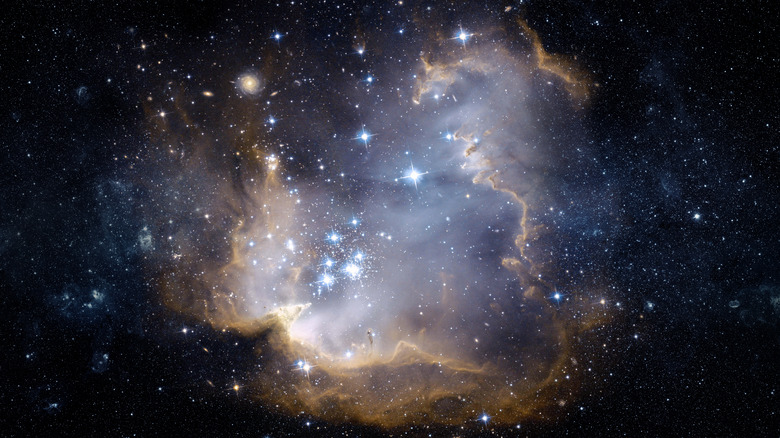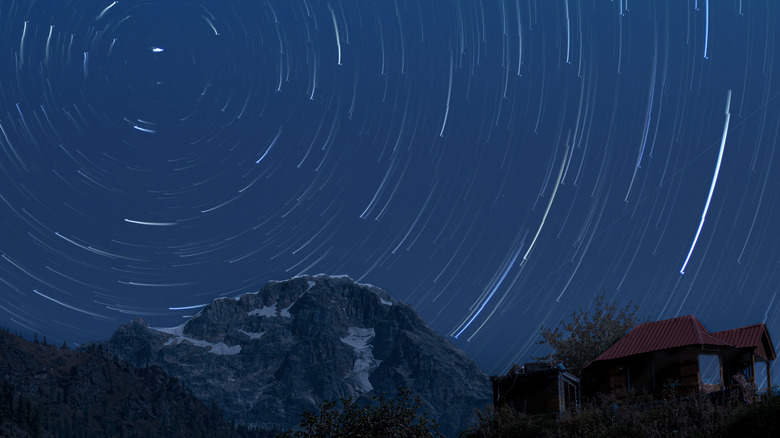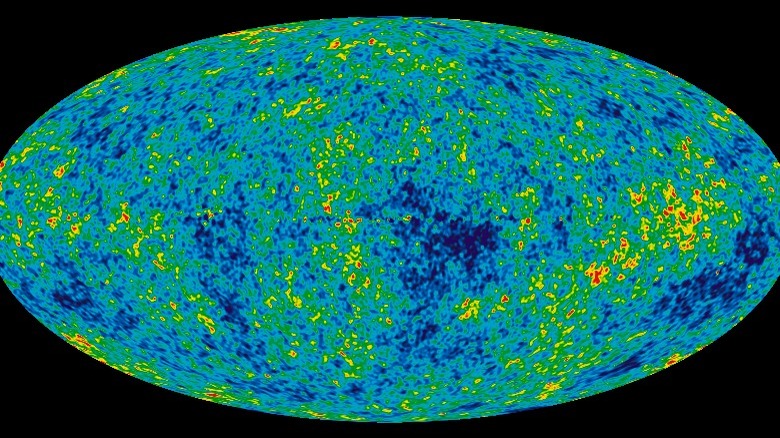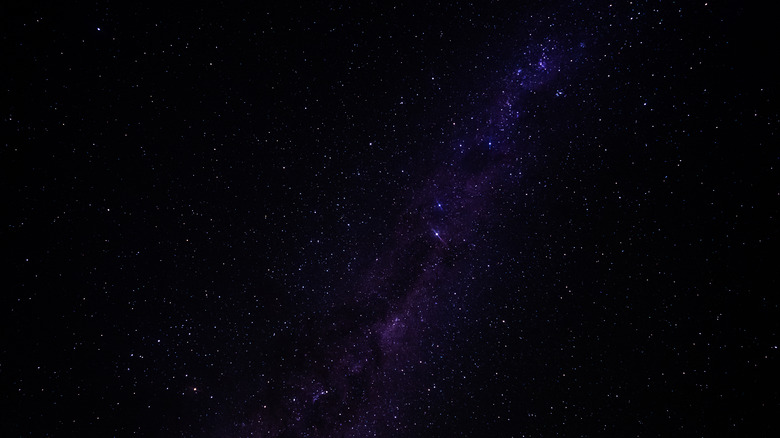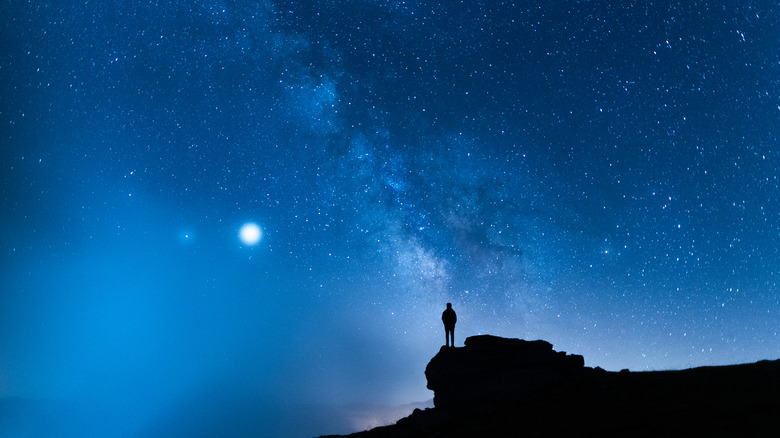This Radical Theory Suggests Our Universe Repeats In Cycles
Reincarnation is part of the beliefs of numerous cultures and religions around the world, past and present, including Buddhists, Hinduists, Sikhs, Jains, and even that ancient Greek triangle guy Pythagoras whose name (and mathematical theorem) you might remember from grade school (as Transcend explains). Of course, it's all a bit more complex than, "then I was a dog, now I am a dude."
As the BBC explains of Hinduism, reincarnation boils down to a built-in belief in the strict division of spirit and matter, known in Western philosophical circles as "dualism" (Philosophy Basics covers the basics). And for the record: if you at all believe in life-after-death, you're a dualist. Reincarnation goes one step further with what we call the "transmigration of souls" from one physical being to another.
For the world's 1.2 billion Hindus (per World Population Review), reincarnation not only occurs on the individual level but on the cosmological level. Satya Yuga, Treta Yuga, Dvapara Yuga, Kali Yuga: these are the four stages of the universe. Each one is shorter than the last, like a constricting spiral, and each full cycle ends in destruction that yields renewal. The last period, Kali Yuga, lasts 432,000 years and is defined by cruelty, power, and animosity. That's where we are now.
Physics, too, has speculated that the universe could repeat. If the universe is shaped like a sphere, it'll eventually do a reverse Big Bang and shrink back on itself, aka the "Big Crunch." But now? We've got another option.
Cyclic, inflating universe balloons
"Cyclic Conformal Cosmology," or "CCC," is the (very unwieldy, but nicely alliterative) name of the new "the universe repeats in cycles" theory. Don't be scared, there won't be a quiz at the end.
CCC is almost 100% put forth by physicist Robert Penrose. Penrose isn't one of those long-dead scientists seen in black and white photos. The U.K.-born, Oxford-affiliated physicist is very much alive, was born in 1931, and won the Nobel Prize in Physics in 2020 for his work on black holes, per the Nobel Prize website. Penrose has also become somewhat of a — not necessarily "pariah" — but the goofy uncle of the scientific community for putting forth CCC, as the snottily titled "No, Roger Penrose, We See No Evidence Of A 'Universe Before The Big Bang'" article on Forbes depicts.
Admittedly, the details of CCC are tough to wrap your head around. Penrose, though, does a stellar (pun intended), layman-accessible job in an interview on Aeon. Ultimately, CCC comes down to predicting the future based on what happened in the past. In this case, "the past" is the Big Bang, which according to Penrose, could also be our distant future.
The Big Bang is one of those theories that's managed to successfully float out to the general public, possibly because it's easy to imagine an inflating balloon. And that's the keyword: inflation (or "cosmic inflation," as NASA outlines). But there's a problem. The universe inflated way more evenly than it should have.
Cosmically smooth peanut butter light
Evidence for the Big Bang comes from Cosmic Microwave Background radiation (CMB, pictured above). If we look out at the universe, we can see that it's permeated by a faint, nearly uniform glow left over from the Big Bang (Scientific American has a good overview). That light — CMB, the oldest light in existence – is about 14 billion years old (13.8, to be exact, per Space), meaning it took 14 billion years to reach us. It really is the case that looking into the sky is gazing into the past; light is our time machine. Even light from the sun takes about 8.33 minutes to reach Earth, as PBS says, so we never know what any cosmic object looks like "now."
But as physicist Robert Penrose points out in his Aeon interview, CMB is too even. Gravity should have clumped matter together into uneven bundles (like our sun). So did gravity somehow pop into existence later? The Big Bang was an infinitely dense, unbelievably hot point, and over time everything cooled and settled into pockets of gas that gravity cohered into stars. So why does light from the early universe seem to be just sort of ... smeared everywhere like smooth peanut butter?
Penrose's answer for this is surprisingly simple: the energy at the start of the universe was already evenly distributed. Meaning, the universe began in a state of what's called "maximum entropy." This could only happen in the far, far distant future.
Maximum entropy locked like ice
When physicists talk about "entropy," they don't mean chaos or disorganization. They mean "randomization." As the universe expands and spreads its matter out further and further, it gets cooler. Things get more spaced apart, and energy transfers (e.g., heat and light) get weaker. This is why physicists currently believe that the universe will end in what's called the "Big Freeze," more ominously called "The Heat Death of the Universe," as outlined on PhysLink. We know this because the universe is a closed system — nothing comes in or goes out. According to Newton's Second Law of Thermodynamics, this means that when energy is transferred, some of it will get invariably wasted, as Live Science summarizes.
Gravity and dark matter aren't strong enough to prevent the universe from expanding forever. In the far distant future (we're talking trillions of years, as the University of Michigan explains), when all stars are dead and even the universe's minefield of black holes sputter to nothing, the universe will become locked in a forever state of absolute, uniform cold. This is known as its "Dark Era." No light, no heat — never again — just a perfectly locked system of purest "entropy" spotted with zipping light.
This means, as Robert Penrose's Conformal Cyclic Cosmology (CCC) proposition continues, that the maximum entropy visible in Cosmic Microwave Background radiation (CMB) makes our universe's past and future geometrically identical. Its "origin" is twin to its dead state, trillions of years from now.
Space wearing a massless light coat
Here's where we tip open our skulls and slot in our big brains. In his Aeon interview, Robert Penrose goes on to explain in more detail how the far past and far future are geometrically identical.
In the universe's Dark Age, when all black holes have dissipated and there are no stars, not even any single atom anywhere, the only thing that will exist is a kind of blanket of light. This light, similar to Cosmic Microwave Background radiation (CMB), will sort of coat the backdrop of the universe, all spread apart. Remember that light is composed of photons, hybrid bundles of particle waves, as ZME Science explains. They're the fastest thing in the universe, with a speed "c" (about 300,000 meters per second, per Space) that nothing can surpass. This is a baked-in value of reality and cause and effect.
The thing is, light has no mass. It "weighs" nothing, and can never stick to other pieces of light like the way atoms form stars. This means that it doesn't experience time, because mass is necessary to experience time. This is also why objects moving through space slower than the speed of light do experience time, in comparison to each other. So, in the far, far future, nothing will exist that can experience time. No time means no distance. No distance means the universe can be infinitely small (like the Big Bang), or infinitely large (like the Big Freeze). It simply doesn't matter.
All evidence to the contrary
So you see how this works, then? The final, furthest state of the cosmos contains only light, and therefore (in order) has no mass, no time, and no distance. You could imagine the entire universe looking very small or very big; size would be irrelevant. The universe would retain the same shape, as Robert Penrose says on Aeon, but lose all its information. Zoom in on one single point in that far, dead future – any point out of an infinite number of points — and the point would look geometrically identical to the Big Bang. So what would exist before the Big Bang, then? Not nothing, just the same universe as now cycling through an eternity of endless expansions. Whoa.
The unfortunate thing with this whole theory is that even Penrose calls it "crazy." In his interview, he says he thought of Conformal Cyclic Cosmology (CCC) simply because a whimpering, eternally frozen universe (the Big Freeze) was just too boring. CCC is not, technically, "physics." It's more philosophy by way of math, like a non-religious version of Hinduism's aforementioned four eras of reality.
This is why Forbes got testy with Penrose. We've got a whole host of data to the contrary of CCC, all of which necessitate an absurdly high temperature at the Big Bang that wouldn't exist at the Big Freeze. That's the difference between the two. For now, it still looks like this is the only universe we will ever get.
